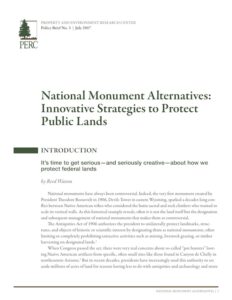 DOWNLOAD THE FULL REPORT
DOWNLOAD THE FULL REPORT
National monuments have always been controversial. Indeed, the very first monument created by President Theodore Roosevelt in 1906, Devils Tower in eastern Wyoming, sparked a decades-long conflict between Native American tribes who considered the butte sacred and rock climbers who wanted to scale its vertical walls. As this historical example reveals, often it is not the land itself but the designation and subsequent management of national monuments that makes them so controversial.
The Antiquities Act of 1906 authorizes the president to unilaterally protect landmarks, structures, and objects of historic or scientific interest by designating them as national monuments, often limiting or completely prohibiting extractive activities such as mining, livestock grazing, or timber harvesting on designated lands.
Given how the act has been used in recent years, it’s no surprise that it continues to generate controversy, especially among the communities most affected by monument designations. By allowing presidents to set aside large swaths of public land with the stroke of a pen, the act’s heavy-handed approach produces acrimony among public land users and opposition from local communities. In response to these concerns, President Donald Trump issued an executive order in late April mandating the review of all monuments created since 1996 that encompass more than 100,000 acres, as well as any others the interior secretary deemed should be reviewed. In total, the Interior Department is reviewing 27 national monuments.
Regardless of the interior secretary’s recommendations or the president’s subsequent action, it is clear that the politicized approach to national monument protection is broken. Many of the designations are made in the eleventh hour of an outgoing president’s term, and any protections these designations actually provide are politically tenuous, as evidenced by the current review process. In the end, one side of the debate will “win,” but the other side will inevitably lose by a commensurate amount, and the current acrimony will only persist.
It is time to get serious—and seriously creative—about finding ways to protect important landscapes while avoiding the acrimony and pitfalls of national monument designations. That is precisely why the scholars at PERC produced this publication. From the sacred tribal artifacts found only in Bears Ears in southeastern Utah to the glacier-carved rivers of the Katahdin Woods and Waters in Maine, this report describes innovative ways to end the acrimony and more effectively protect our lands of cultural and environmental significance.
-
- Native American Management: Tribes can manage their own antiquities sites on federal lands
- National Park Franchises: Franchise partnerships could add parks to the system without adding to the federal maintenance tab
- Trust Management: Trusts could be established to manage landscapes and natural resources for the benefit of the public
- Conservation Leasing: Environmental groups could use markets instead of politics to protect public lands
Download the full report, including endnotes and references.
 DOWNLOAD THE FULL
DOWNLOAD THE FULL








